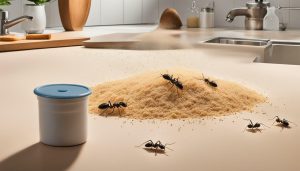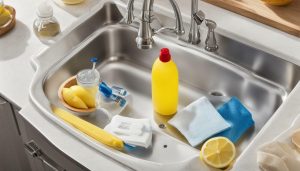Dealing with a clogged kitchen sink can be a frustrating experience, especially when it is fitted with a garbage disposal. It can disrupt your daily routine, cause water backup, and generate unpleasant odors. That’s why it’s essential to know how to unclog a kitchen sink fitted with a garbage disposal to address the issue promptly and prevent further damage. In this article, we’ll provide you with a comprehensive guide on how to unclog your kitchen sink with a garbage disposal, as well as tips and techniques to prevent future clogs.
Key Takeaways:
- Knowing how to unclog a kitchen sink fitted with a garbage disposal can help prevent further damage to your plumbing system.
- Common causes of kitchen sink clogs include food particles, grease, and other debris.
- There are multiple methods for unclogging a kitchen sink with a garbage disposal, including using a plunger, baking soda and vinegar, and a plumbing snake.
- Maintaining your garbage disposal is crucial in preventing future clogs.
- Avoiding common mistakes during the unclogging process can save you time and money.
Understanding the Common Causes of Kitchen Sink Clogs
Dealing with a clogged kitchen sink can be a frustrating experience, especially when you have a garbage disposal unit. While it’s tempting to call a plumber, you may be able to fix the problem yourself with a few simple tools and techniques. But before you attempt to unclog your sink, it’s important to understand what may be causing the blockage.
One of the most common causes of kitchen sink clogs is the disposal of food scraps and other waste down the drain. Even with a garbage disposal unit, food particles can accumulate and create a blockage over time. Grease, coffee grounds, and eggshells are also known culprits for causing clogs. So, it’s important to avoid disposing of these items in your sink.
Another common cause of sink clogs is a buildup of soap and mineral residue on the walls of your pipes. This can occur even if you don’t have a garbage disposal. Over time, this buildup can constrict the flow of water and increase the likelihood of blockages.
So, to prevent future kitchen sink clogs, it’s important to minimize the amount of food waste and debris that goes down your drain. Avoid dumping grease or oils, coffee grounds, and fibrous vegetables like celery and potato peels. You can also use a drain strainer to catch food scraps and prevent them from entering your pipes.
If you do experience a clog, don’t panic. There are several methods you can try to unclog your sink, which we will cover in more detail in the following sections.
Preparing for the Unclogging Process
Before attempting to tackle a clogged kitchen sink with a garbage disposal, it is essential to take necessary precautions and prepare yourself with the right tools. DIY sink unclogging might seem like a daunting task, but with the right approach and knowledge, it can be accomplished successfully. Follow these unclogging tips for kitchen sinks to make sure you have everything you need:
- Turn off the power to the garbage disposal: Safety should always come first. When dealing with any electrical appliances, it is important to ensure that the power is turned off before starting any work. Locate the switch on the wall or under the sink and turn it off before proceeding.
- Prepare your tools: You will need a few basic tools to unclog your kitchen sink with a garbage disposal. These include a bucket, pliers, a plumbing snake, and a flashlight. Keep them handy so you don’t have to look for them later.
- Clear the area around the sink: To avoid any unnecessary hassle, it is recommended to clear the area around the sink. Move any cleaning supplies, dishes, or other objects that might obstruct your access to the sink.
- Tackle any visible blockages: Sometimes, you may be able to identify the source of the clog by looking into the disposal. If you see any visible blockages, use tongs or pliers to remove them before proceeding with the unclogging process.
- Prepare your cleaning solution: If you plan to use a DIY solution to unclog your sink, now is the time to prepare it. Baking soda and vinegar is a popular choice and can be easily found in most households. Mix half a cup of baking soda with half a cup of vinegar and pour it into the disposal. Let it sit for 15 minutes before rinsing with hot water.
By following these simple steps, you can ensure a smooth and safe unclogging process for your kitchen sink with a garbage disposal. Once you are prepared, you can move on to the different methods for unclogging, which will be discussed in the subsequent sections.
Method 1: Using a Plunger
When dealing with a clogged kitchen sink fitted with a garbage disposal, a plunger is an effective tool to try first. Here are the steps:
- Fill the sink with enough water to cover the bottom of the plunger.
- Place the plunger over the drain, making sure it creates a tight seal around the opening.
- Push the plunger up and down vigorously, keeping the seal intact. Repeat for about 20-30 seconds.
- Release the plunger and check if the water drains. If it does, run hot water for a minute to flush out any remaining debris. If it doesn’t, repeat the process a few more times.
If the plunger method doesn’t work, it may be a sign that the clog is more severe. Don’t worry, there are still other methods to try.
Method 2: Using Baking Soda and Vinegar
If the plunger doesn’t work, it’s time to try a different method. One natural DIY solution is to use baking soda and vinegar to unclog your kitchen sink. This method can be effective against grease and food buildup in the garbage disposal.
Here’s what you’ll need:
| Items | Instructions |
|---|---|
| Baking soda | 1/2 cup |
| Vinegar | 1 cup |
| Hot water | 1 pot |
Follow these steps to use baking soda and vinegar:
- Pour 1/2 cup of baking soda down your clogged kitchen sink. Be sure to get it as far down the drain as possible.
- Pour 1 cup of vinegar down the drain. The mixture will fizz, helping to break up the clog.
- Wait for 5-10 minutes, allowing the solution to work its magic.
- Boil a pot of hot water and slowly pour it down the drain to flush away any remaining debris.
Repeat the process if necessary. This method is safe to use on all types of pipes, but remember to always use caution and wear gloves to protect your hands.
Now that you’ve learned how to unclog your kitchen sink using baking soda and vinegar, it’s time to move on to our next method: using a plumbing snake
Method 3: Using a Plumbing Snake
If the plunger and baking soda and vinegar methods don’t work, there’s one more tool you can try: a plumbing snake. This long, flexible wire is designed to navigate through pipes and break up blockages from the inside. Here’s how to use it.
- First, insert the plumbing snake into the drain opening. Slowly push it in until you feel resistance.
- Once you hit the clog, turn the snake’s handle clockwise to break it up. Continue until the snake can move freely through the pipe.
- Remove the snake and run hot water down the drain to flush any remaining debris. Turn on the garbage disposal to ensure it’s working properly.
It’s important to be cautious when using a plumbing snake. Don’t force it down the drain or turn it too forcefully, as this can damage the pipes. If you aren’t comfortable using a plumbing snake, it’s best to call a professional plumber.
Remember, prevention is key when it comes to avoiding clogs in your kitchen sink with a garbage disposal. Be mindful of what you put down the drain and regularly maintain your disposal to keep it running smoothly.
Maintaining Your Garbage Disposal for Prevention
Regular maintenance of your garbage disposal can go a long way in preventing clogs and other issues. Here are a few tips to keep your disposal in top condition:
- Run water before and after use: Always turn on cold water before running your disposal and keep it running for at least 15 seconds after turning off the disposal. This helps flush debris and prevents them from sticking to the blades.
- Use cold water: Hot water can melt fats and grease, causing them to stick to the inside of your pipes. Using cold water will keep these substances solid and flowing towards the disposal.
- Avoid overloading: Do not put too much food waste into your garbage disposal at once. It’s also important to cut large items into smaller chunks before placing them into the disposal.
- Use it regularly: Your disposal needs to be used regularly to prevent rust and corrosion. Running it for a few seconds every day with cold water can help keep it in top condition.
- Clean it regularly: Every few weeks, clean your garbage disposal with a mixture of baking soda and vinegar. Pour 1/2 cup of baking soda into the disposal, then slowly add 1/2 cup of vinegar. Cover the drain with a plug or rag, as the chemical reaction will cause the mixture to bubble and expand. After 10-15 minutes, pour hot water down the disposal to flush away the mixture.
By following these tips, you can help prevent clogs and other issues from occurring and keep your garbage disposal functioning properly.
Garbage Disposal Troubleshooting
If you encounter any issues with your garbage disposal, here are a few troubleshooting steps to take:
- Reset the disposal: If the disposal is not working, try pressing the reset button located at the bottom of the unit underneath the sink. This will reset the circuit breaker and may solve the issue.
- Check for clogs: If the disposal is making a humming noise but not grinding food, there may be a clog in the unit. First, turn off the power to the disposal by unplugging it or turning off the circuit breaker. Use a flashlight to look into the disposal and remove any visible clogs with tongs or pliers. Never put your hand inside the disposal.
- Sharpen the blades: If the disposal is working but not grinding food effectively, the blades may be dull. Run a few ice cubes through the disposal to help sharpen the blades.
If these steps do not solve the issue, it may be time to contact a professional plumber for further assistance.
Additional Tips to Consider
If the methods outlined in the previous sections do not work, or if the clog seems too severe, consider contacting a professional plumber for assistance. Attempting to fix a complex clog without the necessary experience or tools can lead to further damage or even injury.
When attempting to fix a clogged sink with a garbage disposal, avoid using chemical drain cleaners. These products can be harmful to the environment and the plumbing system, causing corrosion and further damaging the pipes.
To prevent clogs from forming in the first place, consider installing a drain strainer or catch basket. These devices can help catch food particles and other debris before they can cause a clog. Additionally, avoid pouring grease or oil down the drain, as these substances can solidify and cause blockages.
If you experience persistent clogging despite your best efforts, it may be time to consider upgrading your garbage disposal. A newer model with more power and efficient grinding capabilities may be able to handle tougher food scraps and prevent clogs from forming.
Always be cautious and follow safety protocols when attempting to unclog a kitchen sink with a garbage disposal. Turn off the power to the disposal and never put your hands or fingers into the disposal chamber. Use tool handles or other objects to free any stuck debris.
Common Mistakes to Avoid
While attempting to unclog a kitchen sink with a garbage disposal, it’s important to avoid these common mistakes:
- Using chemical drain cleaners: Drain cleaners can damage your pipes and harm the environment. They may also fail to fully remove the clog, leading to a recurring issue.
- Overloading the garbage disposal: Trying to dispose of too much food waste at once can overwhelm the garbage disposal and lead to clogs.
- Using hot water: Hot water can cause grease to liquefy and stick to your pipes, worsening the clog over time.
- Using the wrong tools: Using the wrong type of plunger or attempting to force a plumbing snake through a bend in the pipe can damage your plumbing.
- Ignoring warning signs: If you notice slow draining or unusual noises coming from your sink, it’s important to address the issue promptly before it becomes a more serious clog.
By avoiding these mistakes and following the tips outlined in this article, you can successfully unclog your kitchen sink fitted with a garbage disposal and prevent future issues.
Conclusion
Dealing with a clogged kitchen sink fitted with a garbage disposal can be a frustrating experience. However, with the right tools and techniques, you can quickly unclog your sink and prevent future blockages. Remember to start by identifying the cause of the problem, whether it’s food particles, grease, or other debris.
Once you’re prepared to tackle the issue, try using a plunger, baking soda and vinegar, or a plumbing snake, depending on the severity of the clog. If you’re not comfortable attempting these methods yourself, it’s always best to call in a professional plumber.
Don’t forget to maintain your garbage disposal regularly to avoid future clogs. Clean it regularly, sharpen the blades, and avoid putting problematic items down the disposal. By taking these preventative measures, you can keep your kitchen sink running smoothly for years to come.
Remember, the key to unclogging your kitchen sink is to act quickly. Don’t let a small clog turn into a major plumbing issue. With the tips and techniques outlined in this article, you can easily unclog your kitchen sink and avoid costly repairs.
FAQ
Q: What are the common causes of kitchen sink clogs?
A: The common causes of kitchen sink clogs include food particles, grease, and other debris that accumulate in the pipes, especially in sinks fitted with garbage disposals.
Q: How can I prevent future kitchen sink clogs?
A: To prevent future kitchen sink clogs, avoid putting large amounts of food scraps down the garbage disposal, use a sink strainer to catch debris, and regularly clean and maintain your garbage disposal.
Q: What preparations should I make before unclogging a kitchen sink with a garbage disposal?
A: Before unclogging a kitchen sink with a garbage disposal, ensure that the power to the disposal is turned off, gather the necessary tools such as a plunger or plumbing snake, and protect yourself with gloves and safety glasses.
Q: How can I unclog a kitchen sink using a plunger?
A: To unclog a kitchen sink using a plunger, place the plunger over the drain and create a tight seal. Then, pump the plunger up and down vigorously to dislodge the clog. Repeat as necessary until the water starts draining.
Q: Can I use baking soda and vinegar to unclog a kitchen sink with a garbage disposal?
A: Yes, you can use baking soda and vinegar to unclog a kitchen sink with a garbage disposal. Pour half a cup of baking soda down the drain, followed by half a cup of vinegar. Let the mixture sit for a few minutes, then flush it with hot water.
Q: How do I use a plumbing snake to unclog a kitchen sink?
A: To use a plumbing snake, insert the snake into the drain until you reach the clog. Rotate the snake while pushing it forward to break up the blockage. Once the snake has made its way through the clog, pull it out while continuing to rotate to remove the debris.
Q: How can I maintain my garbage disposal to prevent clogs?
A: To maintain your garbage disposal and prevent clogs, regularly clean it by grinding ice cubes and lemon peels, avoid putting fibrous or greasy foods down the disposal, and periodically sharpen the disposal blades.
Q: What are some additional tips for unclogging a kitchen sink with a garbage disposal?
A: Some additional tips for unclogging a kitchen sink with a garbage disposal include using a wet/dry vacuum to remove stubborn clogs, checking the dishwasher drain connection, and consulting a professional plumber if the clog persists.
Q: What common mistakes should I avoid when unclogging a kitchen sink?
A: Common mistakes to avoid when unclogging a kitchen sink include using chemical drain cleaners, using excessive force that could damage the pipes, and neglecting regular maintenance of the garbage disposal.
Q: How important is it to address a clogged kitchen sink promptly?
A: It is important to address a clogged kitchen sink promptly to prevent further damage and inconvenience. Ignoring a clog can lead to backups, unpleasant odors, and potential damage to the garbage disposal or plumbing system.

It’s me, Amber Hayden, the heart and soul behind SagarmathaOnlineMedia.com. From a young age, I’ve been head over heels for everything home-related, from interior decor to gardening. I’m the type who can’t resist a well-crafted piece of furniture, and I firmly believe that a home isn’t complete without a pet or two. But it’s not just about creating pretty spaces for me. I’m all about making homes that tell a story reflecting the people living there. SagarmathaOnlineMedia.com is my way of sharing this passion with you. Whether you’re looking for tips to jazz up your living room, advice on pet care, or ideas to make your garden bloom, I’m here to help. So, let’s embark on this journey together and make your house a home!



